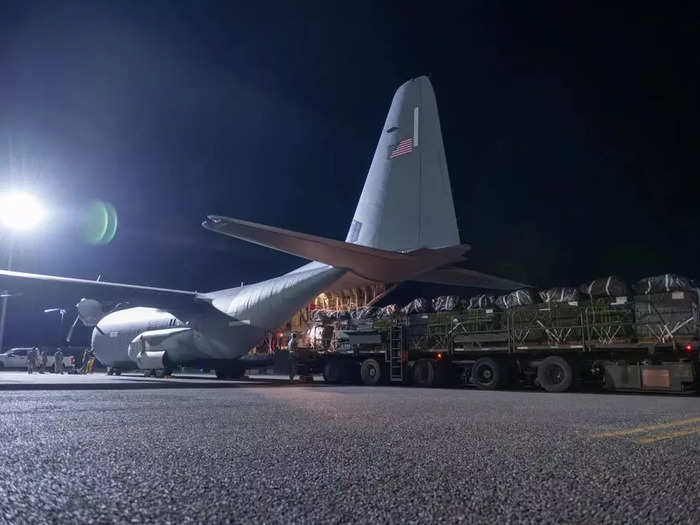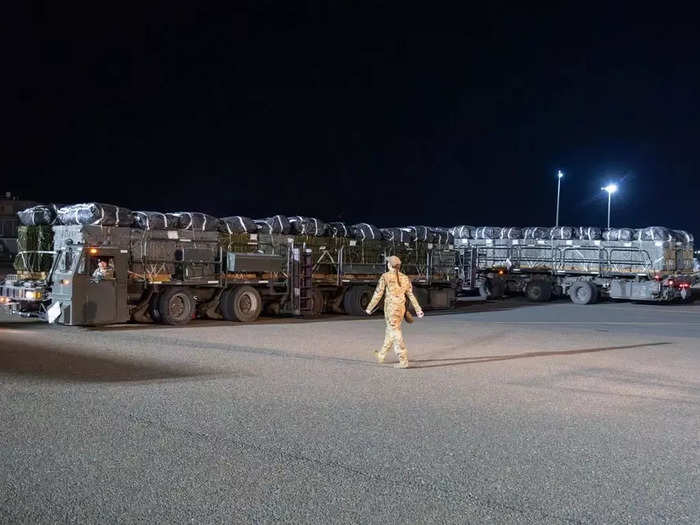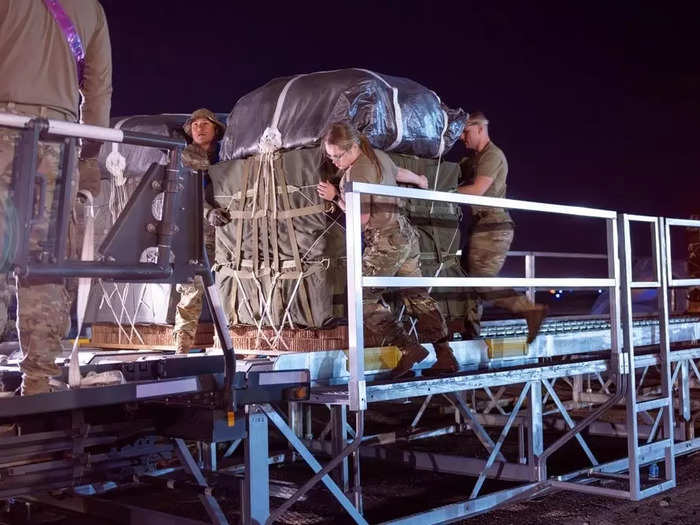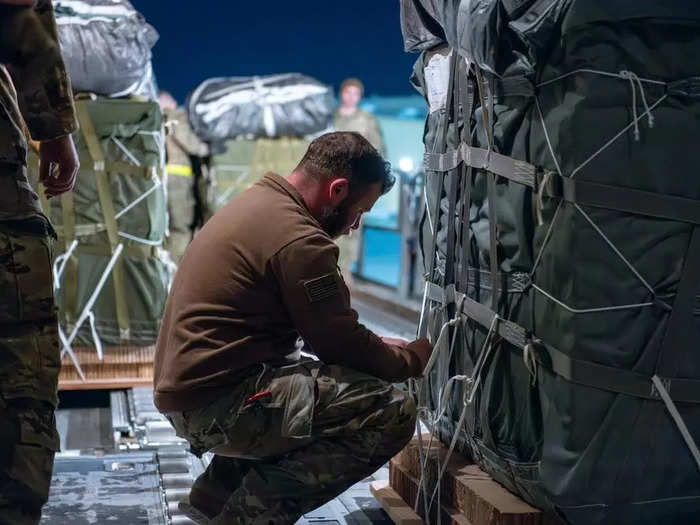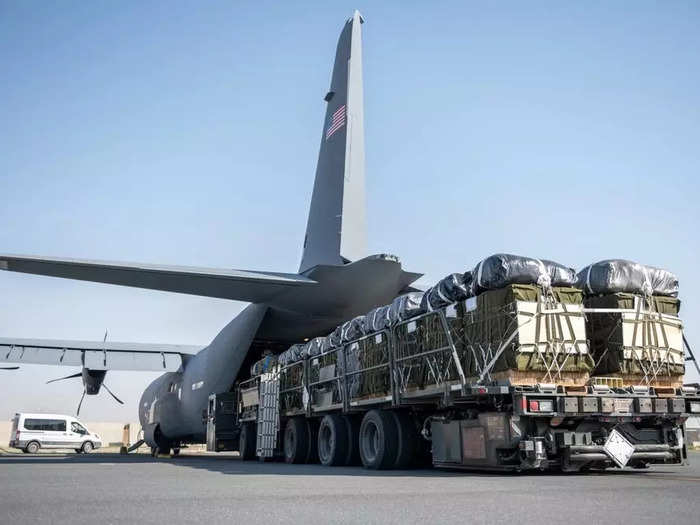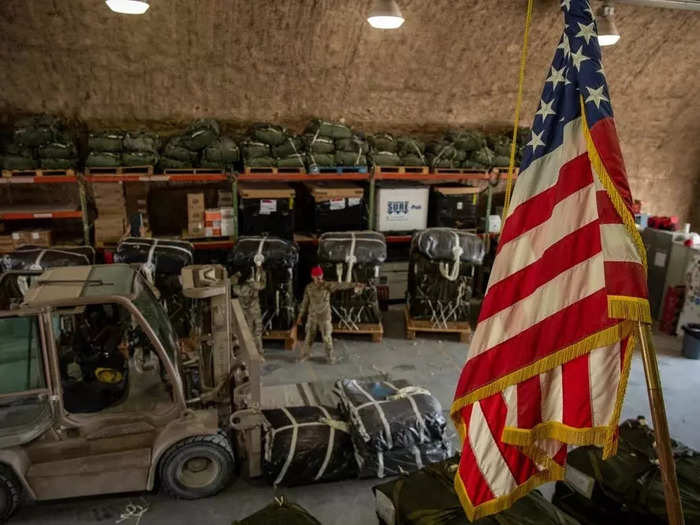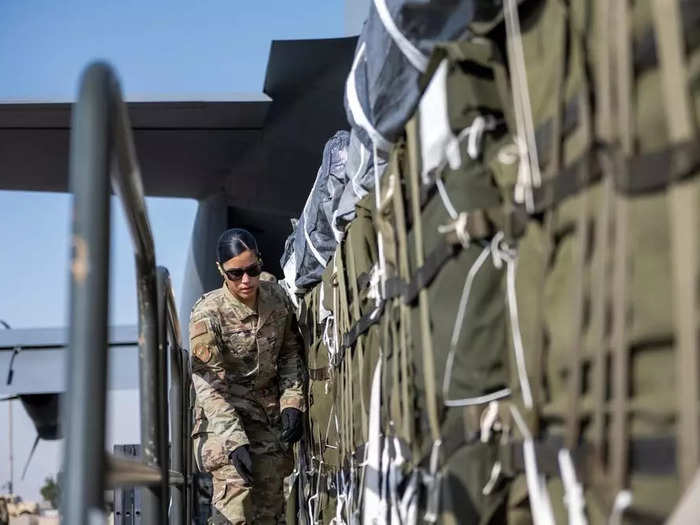A US airman stands on the ramp of a C-130J Combat King II after airdropping humanitarian aid to Gaza.US Air Force photo by Staff Sgt. Christian Sullivan
- The US and other countries delivered humanitarian aid to residents in the Gaza Strip this month.
- Photos showed US military personnel loading pallets of aid aboard a C-130J Super Hercules.
The US carried out its first military airdrop into Gaza earlier this month, delivering thousands of meals and other humanitarian aid to the war-torn enclave.
These images show how the US Air Force is carrying out the humanitarian missions that advocates warn aren't enough.
Loading the C-130J Super Hercules
A US Air Force C-130J Super Hercules is loaded with humanitarian aid destined for an airdrop over Gaza. US Air Force photo
Photos showed US Air Force aerial port airmen and US Army parachute riggers loading pallets of aid aboard a C-130J Super Hercules, a four-engine military transport aircraft.
Nearly 40,000 meals to Gaza
US Air Force K-loaders filled with pallets of Halal meals destined for an airdrop over Gaza are readied for load onto a C-130J Super Hercules. US Air Force photo
US Central Command and the Royal Jordanian Air Force jointly carried out the airdrop, which included 38,000 Halal meals for residents of the Gaza Strip.
Nearly 2 million people live in the 140-mile enclave, one of the most densely populated areas in the world that's seen massive destruction during Israel's response to the October 7 Hamas terrorist attacks.
US Central Command said the airdrops are part of a "sustained effort" to get more aid to Gaza residents, providing "essential relief to civilians affected by the ongoing conflict."
On the brink of famine
US Air Force Aerial Port Airmen and US Army parachute riggers usher in pallets of humanitarian aid destined for Gaza onto a K-loader. US Air Force photo
The White House said the airdrop was the first of many to come following criticism from humanitarian groups that the aid wasn't enough. US President Joe Biden first announced the airdrops on March 1 after months of calling on Israel to allow more aid into Gaza.
"We need to do more, and the United States will do more," Biden told reporters.
The UN Office for the Coordination of Humanitarian Affairs said at least a quarter of the population in the Gaza Strip are on the brink of famine.
A deadly failed airdrop
US Air Force airmen and US Army soldiers prepare bundles of humanitarian assistance for airdrop aboard a C-130J Super Hercules. US Air Force photo
Along with the US, other countries have conducted airdrops to provide aid to Palestinians, including Jordan, Egypt, and the United Arab Emirates.
At least five people were killed and 10 injured after a failed military airdrop on Friday. It wasn't immediately clear which country was behind the airdrop, but the Pentagon press secretary denied that a US airdrop caused the deaths.
In a video obtained by CNN, a parachute appeared to malfunction and failed to deploy, causing the pallet and its contents to dangerously descend toward a residential building in western Gaza. The pallets' contents are seen coming apart as it falls to the ground, CNN reported.
Airdrops have been criticized as ineffective
A US Air Force C-130J Super Hercules aircraft airdrops 66 pallets of food over Gaza. US Air Force photo
The airdrop method has been criticized as an ineffective way to deliver aid, especially given the scale of need in Gaza as the brutal war between Israel and Hamas rages.
"Humanitarian workers always complain that airdrops are good photo opportunities but a lousy way to deliver aid," Richard Gowan, the International Crisis Group's UN Director, told Reuters.
"It is arguable that the situation in Gaza is now so bad that any additional supplies will at least alleviate some suffering," Gowan continued. "But this, at best, is a temporary Band-Aid measure."
Lacking essential food supplies
A US Air Force K-loader filled with pallets of Halal meals destined for an airdrop over Gaza is readied for load onto a C-130J Super Hercules. US Air Force photo
Abdel Qader Al Sabbah, a journalist based in northern Gaza, told CNN that some recent military airdrops haven't included non-perishable food supplies and instead are providing single portions that have to be eaten on the day, rendering them "useless."
"You are lucky if you even get a hold of these meals," Al Sabbah said. "I don't even bother to go searching for these aid parcels because people are always fighting over them."
The US airdrops, however, have been the shelf-stable Meals-Ready-to-Eat that troops eat in the field but in amounts that are inadequate to demand so far.
A temporary pier on the Gaza coast
US service members prepare pallets of meals, ready-to-eat, and bottled water to be sent through humanitarian aid airdrops into Gaza. Photo by Spc. Nataja Ford
In addition to airdrops, Biden pledged during his State of the Union address Thursday that he would order the military to build a temporary pier in the Mediterranean on the Gaza coast to deliver more food, water, medicine, and temporary shelters.
He said "no US boots will be on the ground" in building the port, which would "enable a massive increase in the amount of humanitarian assistance getting into Gaza every day."
'Humanitarian assistance cannot be a secondary consideration or a bargaining chip'
A US airman prepares bundles of humanitarian aid destined for an airdrop over Gaza. US Air Force photo
"Israel must allow more aid into Gaza and ensure that humanitarian workers aren't caught in the crossfire," Biden said. "To the leadership of Israel, I say this: humanitarian assistance cannot be a secondary consideration or a bargaining chip."
"As we look to the future, the only real solution is a two-state solution. I say this as a lifelong supporter of Israel and the only American president to visit Israel in wartime," he added. "There is no other path that guarantees Israel's security and democracy. There is no other path that guarantees Palestinians can live with peace and dignity. There is no other path that guarantees peace between Israel and all of its Arab neighbors, including Saudi Arabia."
The US involvement in the conflict is complicated and increasingly controversial, as it is both providing limited humanitarian aid to Palestinians in Gaza while also providing military support and weapons to Israel.
In late February, Israeli forces fired into a crowd of Palestinians waiting for food from an aid convoy, killing more than 100 people. The attack came a month after reports that Biden is considering curtailing some of its lethal aid to Israeli forces.

